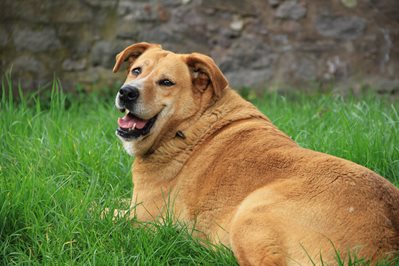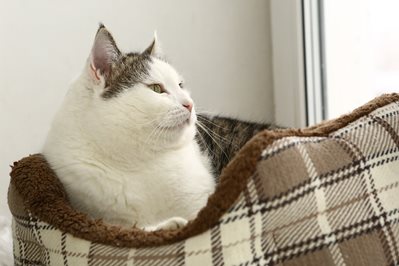Did you know that it is possible to consume in excess of 6000 calories on Christmas Day? Many of us will have started the year with new healthy eating, less alcohol and intensive exercise intentions, but with medical research suggesting that over 40% of the human population will be obese by 2030, are our pets far behind?
Up to 60% of cats and dogs are obese (1) and this is a growing problem across the country. Just like in humans, there are lots of factors in the reasons for obesity and a long list of health problems that can occur as a result.
Why does it matter if my pet is overweight?
If your pet is overweight they are more likely to suffer from many different conditions, similar to the risks associated with obesity in humans.
Diabetes is a condition that is commonly discussed in the same breath as human obesity, and our pets are no different. This is a disease that can make our pets very sick, and signs include weight loss while remaining very hungry, increased thirst and increased urination. Also look out for clouding in your pet’s eyes; this may be a formation of cataracts, a problem that is related to diabetes. Diabetes can be managed with the injection of twice daily insulin, however, it can take a long time to stabilise patients, with many trips to the vet for blood tests. Keeping your pet at a healthy weight drastically reduces the risk of them becoming diabetic.
Pancreatitis is a common condition in cats and dogs, and in dogs is usually related to a high fat diet. This is a painful condition which can cause vomiting, diarrhoea and lethargy, and usually requires a stay in the hospital to treat. Feeding your dog an appropriate diet without high fat treats can help to prevent pancreatitis.
Joint problems and arthritis are more common in overweight cats and dogs. Being obese puts extra strain on all the joints and can lead to ligament damage or chronic change to joints that may require medication or even surgery to manage.
Skin sores and yeast infections can be a problem in overweight pets. Some breeds of dog are more likely to suffer from yeast infections due to skin folds, such as English Bulldogs, but the inability to groom due to obesity and sores from inactivity can be avoided by keeping your pet at a healthy weight.
How will I know if my pet is obese?
Obesity is diagnosed with a measure known as “Body Condition Score”. This focuses on the fat your pet is carrying, rather than the weight, since all our pets come in different shapes and sizes. Sometimes it is obvious to us that our pet has gained weight, or that they may be obese, but studies have shown that pet owners often underestimate their pet’s body condition score (2).
At your pet’s regular health check ups the vet or veterinary nurse will check your pets weight and body condition score. If you are worried that your pet may be overweight we run free of charge weight clinics at all of the Kingston branches so please ring to make an appointment.

What are the reasons for my pet being obese?
There are many different factors in the likelihood of our pets becoming overweight. Genetics play a part and some dog and cat breeds are more likely to be obese than others, including Labradors and domestic short haired cats.
However, there are more factors involved which we can modify. Diet plays an important factor in your pet’s weight, not only how much they eat, but also what it is they are eating. Free choice and ad lib feeding, as well as table scraps make a huge difference to the number of calories your pet is consuming and all types of human foods are often higher in calories than we think. One slice of buttered toast is the equivalent of a whole hamburger to a 10kg dog, and a glass of milk 4 ½ hamburgers to the average cat!
Inactivity is also related to obesity. Indoor cats tend to have a less active lifestyle than their outdoor counterparts, and lots of walks are more likely to keep your dog at a healthy weight.
A lack in the diversity of gut bacteria has been linked to obesity in both humans and dogs, however, in our pets the studies looking into the use of this information only show preliminary data.
My pet is obese, what do I do know?
Once your pet has been diagnosed by a vet or a veterinary nurse as obese we will help you make a plan to get your pet back to a healthy weight. This will involve a diet and exercise plan, and regular free of charge weight checks.

Diet choice is really important in your pet’s weight loss program, in order to make sure they receive all the nutrients they need, while having restricted calories. Normal dog foods that you feed your pet, even the “light” or “reduced-calorie” versions are not recommended, as with reducing the amount you feed you almost definitely not provided the required amount of protein for maintaining your pet’s muscle mass, which is important to prevent future weight gain. Veterinary weight loss diets are formulated so that a reduced calorie intake is achieved while providing the appropriate amount of protein and other nutrients.
A lot of people worry about the cost associated with veterinary diets, since these usually cost more per bag than other pet foods, however, when taking into account restricted portions the cost of feeding is usually the same.
It is important to work out the amount you should feed your pet with the help of a veterinary nurse. This is worked out using a calculation that factors in your pet’s metabolic rate and makes sure they get all the nutrients they need.
Once you get started on your pet’s weight loss journey, dogs are invited to “Fit Club” held monthly on a Sunday morning at the Anlaby Surgery. Getting to know other dog owners can really help to keep you and your pet motivated, and all our members are doing really well!
Summary:
Obesity is a growing problem in our pets. Although there are some factors that we cannot control, there are lots of things we can do to keep our pets at a healthy weight, and prevent obesity related diseases in later life.
Larsen JA and Villaverde C (2016). Scope of the problem and perception by owners and veterinarians, Veterinary Clinics of North America: Small Animal Practice46(5): 761-772.
Courcier EA, Mellor DJ, Thomson RM and Yam PS (2011). A cross sectional study of the prevalence and risk factors for owner misperception of canine body shape in first opinion practice in Glasgow, Preventive Veterinary Medicine102(1): 66-74.